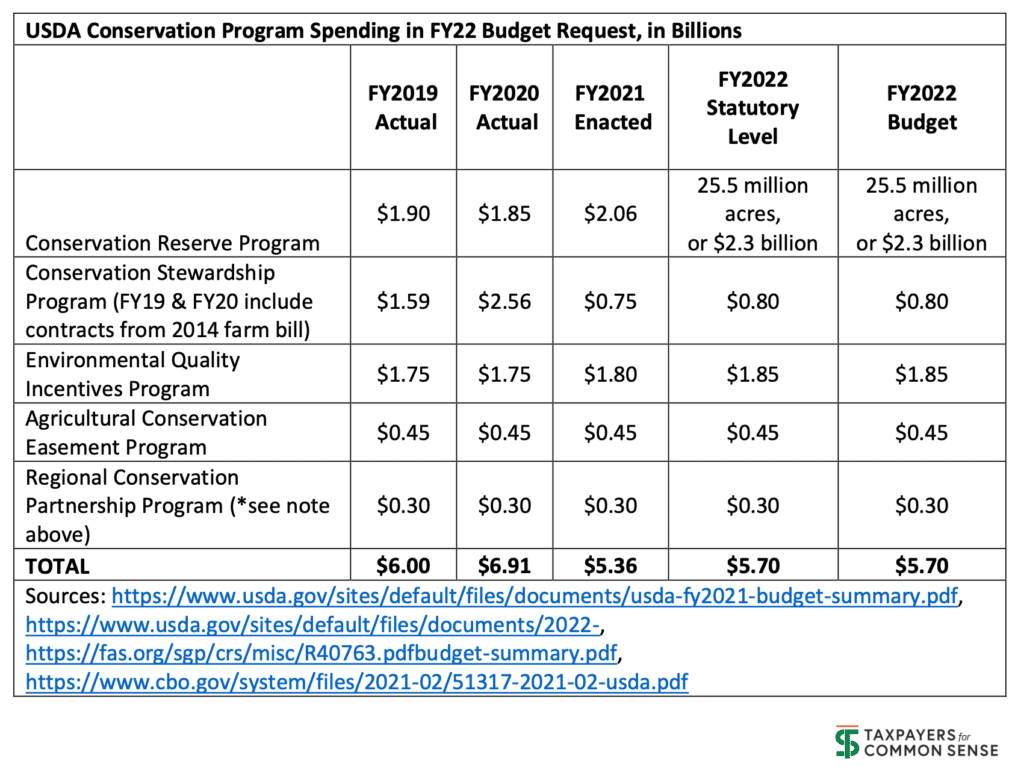President Biden’s first U.S. Department of Agriculture (USDA) FY22 budget request proposes status quo funding levels for agriculture conservation programs. Funding for working lands programs like the Conservation Stewardship Program (CSP) and land set-aside programs like the Conservation Reserve Program (CRP) is proposed at levels consistent with the 2018 farm bill. (Working lands programs fund conservation practices and installations on land currently in agricultural production while set-aside programs fund grassland establishment and tree plantings, for instance, on land not currently producing crops). The budget scratches the surface on investing in better prioritization, monitoring, and evaluation of environmental and climate benefits in USDA conservation program funding, but a long road lies ahead.
In previous years, the Trump Administration proposed $9 billion in conservation cuts (to CSP in particular) over ten years. Congress also has a history of proposing – and implementing – real cuts to conservation program funding as well. Congress has historically CHIMPed conservation programs, meaning mandatory funding in the farm bill was cut through Congress’s annual discretionary appropriations process. In Congress-speak, CHIMPs are “Changes in Mandatory Programs.”
The Biden budget, however, proposes no cuts. If anything, the budget proposes to increase funding for the Regional Conservation Partnership Program (by $100 million each year for four years to increase “the adoption of on-farm resources management practices and technology that supports net-zero carbon emissions”), but this plus-up is not reflected in the budget’s corresponding tables.

One bright spot is the administration’s mentioning of better climate measuring and monitoring, including:
“new investments across USDA will focus on climate change research and assessment, measurement and monitoring, efforts to mitigate greenhouse gas emissions, increasing carbon sequestration, and providing other benefits in avoiding or adapting to domestic and global climate change impacts.”
However, as we wrote after the release of Biden’s skinny budget in April, the devil is in the details. Unfortunately, USDA doesn’t say specifically how this would be implemented broadly in practice. Ensuring taxpayer dollars are targeted at programs with the best return on investment is vital, but the budget is short on details. While we have called for better monitoring, measurement, and verification in agriculture conservation programs in the past, USDA has only provided specifics on CRP. One program is better than nothing. However, these types of prioritizations must be implemented at a wider scale for a real change. Conservation programs can be an effective tool to increase the economic and environmental resilience of farming and ranching businesses. But USDA must do more to ensure the $5-6 billion taxpayers spend on agriculture conservation each year is prioritized toward the most cost-effective and accountable practices and programs.
A few steps in the right direction, though, include:
- Targeted CRP funding: Just announced in April, USDA is beginning to target CRP funding at ways producers can increase carbon sequestration. A new Climate-Smart Practice Incentive in CRP was introduced for the “establishment of trees and permanent grasses, development of wildlife habitat, and wetland restoration.”
- Focus on monitoring and evaluation: USDA plans to invest $10 million in the CRP Monitoring, Assessment and Evaluation (MAE) program “to measure and monitor the soil carbon sequestration and other climate and environmental benefits of conservation practices over the life of CRP contracts” in cooperation with university extension researchers.
Prioritizing effective conservation that leads to better climate, environmental, and producer resilience is key to ensuring investments return the best bang for the buck. However, simply spending more on climate initiatives and conservation programs – without removing underlying perverse incentives and eliminating obstacles to conservation within existing farm safety net programs – will not help achieve the president’s climate goals. Nor will farmers be better off in the short- or long-term.
We’re happy to see USDA is taking steps to reform and target funding in existing conservation programs, rather than simply proposing more taxpayer spending on a yet-undefined carbon bank. However, the budget only scratches the surface. To improve water quality, climate outcomes, and producer resilience to future challenges, farm commodity and crop insurance subsidies must first be reformed. Otherwise, they will continue to promote undue risk taking at taxpayer expense and production over climate resilience. Other steps can be taken to help ensure government programs do not work at cross purpose with one another and instead prioritize conservation that leads to the best environmental and taxpayer outcomes.










